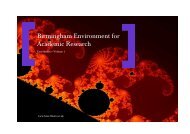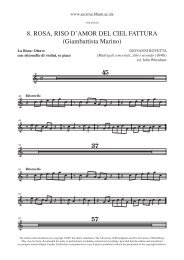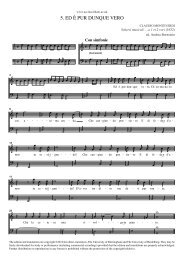Monteverdi Scherzi Musicali 1632 - University of Birmingham
Monteverdi Scherzi Musicali 1632 - University of Birmingham
Monteverdi Scherzi Musicali 1632 - University of Birmingham
- No tags were found...
Create successful ePaper yourself
Turn your PDF publications into a flip-book with our unique Google optimized e-Paper software.
www.ascima.bham.ac.ukxxviOn the rationale for this policy see GiuseppinaLa Face Bianconi, ‘Filologia dei testi poetici nellamusica vocale italiana’, Acta musicologica, 66(1994), 1-21, 139.In presenting the texts as literary entities, thereconstruction and classification <strong>of</strong> the poeticform is editorial in those cases in which no literarysource is known.None <strong>of</strong> the texts set by <strong>Monteverdi</strong> is attributedto a poet in the musical source, and are withoutpunctuation except for a final full stop. All otherpunctuation is, therefore, editorial, as are theclassifications <strong>of</strong> the texts and their attributionsto individual poets. The use <strong>of</strong> capital lettersat the beginning <strong>of</strong> each line is, generally,editorial, though it reflects common sixteenthandseventeenth-century literary usage. In themusical settings, the beginnings <strong>of</strong> poetic lines aresignalled in the edition <strong>of</strong> the musical settings bythe use <strong>of</strong> capital letters. For the identification <strong>of</strong>poets and poetic sources see REPIM. Repertoriodella Poesia Italiana in Musica, 1500-1700 (ed.Angelo Pompilio): http://repim.muspe.unibo.it/default.aspx.In the musical settings, text repetition indicatedin the source by an idem sign (‘ii’ or ‘ij’) is shownin italics. Text added by the editor is enclosed inbrackets.In the musical settings, elisions betweensyllables are shown editorially by an elisioncharacter joining the relevant syllables.Sulle ragioni delle scelte anzidette, si vedal’articolo di Giuseppina La Face Bianconi,«Filologia dei testi poetici nella musica vocaleitaliana», Acta musicologica, 66 (1994), pp. 1-21,139.Nella presentazione dei testi come entità letterarieautonome, la ricostruzione e la classificazionedelle forme poetiche è del curatore, a meno chenon sia nota una valida fonte letteraria del branoin oggetto.La fonte non attribuisce mai i testi impiegati.Inoltre, i essi sono privi di punteggiatura, conl’eccezione del punto conclusivo. Pertanto, tutta lapunteggiatura è del curatore, il quale si è inoltreoccupato di classificare metricamente i testi edi attribuirli – quando possibile – a un autore.L’impiego delle lettere maiuscole a capoverso èdovuto nella maggior parte dei casi al curatore,sebbene quest’uso rifletta quello usualmenteimpiegato nella poetica dei secoli XVI e XVII.Nella trascrizione delle musiche, l’inizio dei versi èsempre in maiuscolo. Riguardo all’identificazionedei poeti e delle fonti letterarie, si veda REPIM.Repertorio della Poesia Italiana in Musica, 1500-1700 a cura di Angelo Pompilio: http://repim.muspe.unibo.it/default.aspx.Le parti di testo indicate nell’originale dalle sigle«ij» o «ii» (idem) sono state trascritte in corsivo.Il testo aggiunto dal curatore è invece tra parentesiquadre.Nella trascrizione delle musiche, la sinalefeè segnalata da una legatura che unisce le sillabeinteressate.Für eine Begründung dieser Vorgehensweises. Giuseppina La Face Bianconi, „Filologia dietesti poetici nella musica vocale italiana“, Actamusicologica 66 (1994), S. 1-21; 139.Wo keine literarische Quelle bekannt ist, handeltes sich bei der Rekonstruktion und Klassifizierungder poetischen Form zum Zwecke der Präsentationder Texte als literarische Einheiten um einenEingriff des Herausgebers.In der musikalischen Quelle ist keiner dervon <strong>Monteverdi</strong> vertonten Texte einem Dichterzugeschrieben. Die Texte haben mit Ausnahmeeines Punktes am Ende keine Satzzeichen. Alleweiteren Satzzeichen sowie die Großbuchstabenam Zeilenbeginn (die den Gebrauch in derLiteratur des 16. und 17. Jahrhunderts reflektieren)sind demnach – ebenso wie ihre Klassifizierungsowie die Zuordnung zu individuellen Dichter– Zusätze des Herausgebers. Im Notentext wirdder Anfang der Textzeilen der Gedichte durch dieVerwendung von Großbuchstaben signalisiert.Zur Identifikation von Dichtern und dichterischenQuellen s. REPIM. Repertorio della Poesia Italianain Musica, 1500-1700 a cura di Angelo Pompiliohttp://repim.muspe.unibo.it/ default.aspx.Im Notensatz werden Textwiederholungen, diein der Quelle durch ein Wiederholungszeichen (iior ij) markiert sind, in Kursivbuchstaben gedruckt.Textzusätze des Herausgebers erscheinen inKlammern.Im Notentext wurden Auslassungen zwischenSilben durch Auslassungszeichen zwischen denbetreffen Silben vom Herausgeber kenntlichgemacht.








